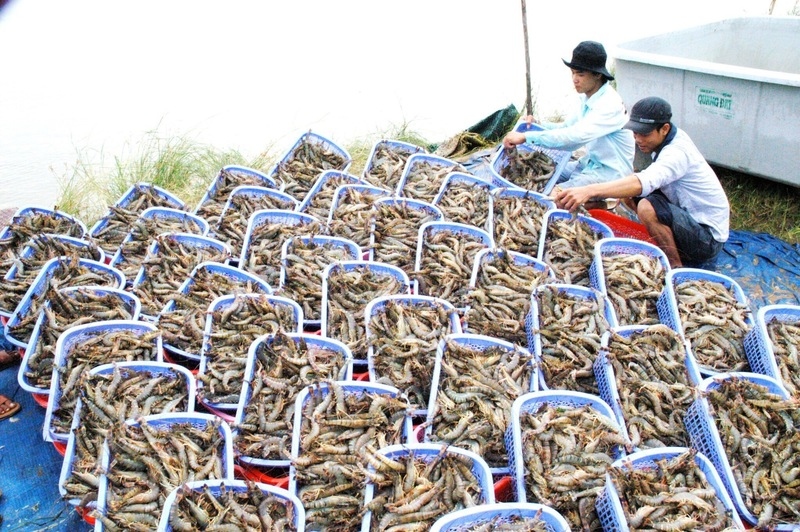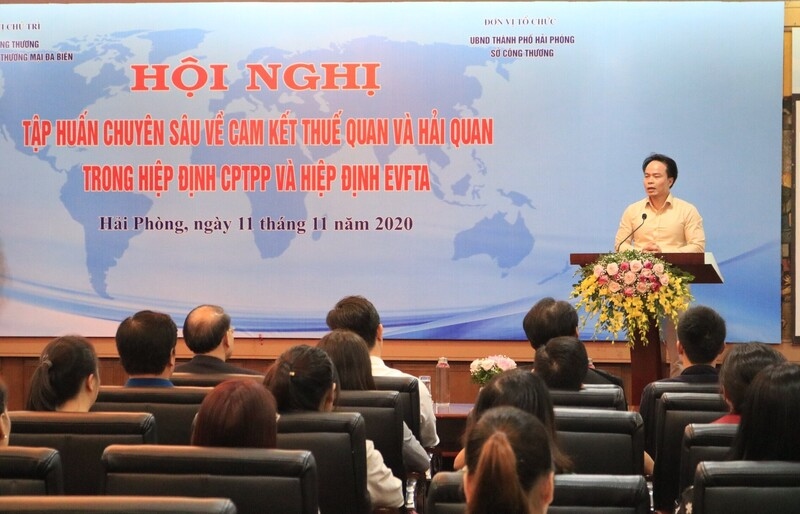On August 1, 2020, the EVFTA officially came into effect, opening a new chapter in cooperation between Vietnam and countries in the European Union. Especially after 5 years of implementation, the EVFTA has brought significant benefits, contributing to promoting trade growth between Vietnam - EU and with many partners around the world.
On this occasion, Industry and Trade Newspaper had an interview with Mr. Ngo Chung Khanh - Deputy Director of the Multilateral Trade Policy Department, Ministry of Industry and Trade:
The rate of enterprises taking advantage of tariff preferences from the EVFTA is increasing
- Could you share the positive impacts of the EVFTA on trade growth between Vietnam and the EU after 5 years of the Agreement officially taking effect?
Deputy Director Ngo Chung Khanh: In terms of bilateral trade turnover, since 2020 when the Agreement came into effect, bilateral trade turnover has increased from USD 55.4 billion in 2020 to USD 68.3 billion in 2024. In which, Vietnam's export turnover to the EU reached USD 40.1 billion in 2020, increasing to USD 51.6 billion in 2024, up about 28.6%, and the trade surplus between Vietnam and the EU increased from USD 24.8 billion in 2020 to USD 34.9 billion.
Along with that, the rate of enterprises and industries taking advantage of the Agreement has seen very positive results; among them, many industries such as agriculture, fisheries, textiles, footwear... have been making very good use of it. These are the initial results; the EVFTA has brought very positive benefits to bilateral trade and to Vietnam's key export industries.

Mr. Ngo Chung Khanh - Deputy Director of the Multilateral Trade Policy Department, Ministry of Industry and Trade giving an interview on the positive impacts brought by the EVFTA
However, although the absolute value has increased, in terms of the proportion of exports to the EU market in Vietnam's total exports, the increase is not significant and has not met expectations. This is a point to note because the EU is a large and traditional market, but the market share of some of Vietnam's export items remains relatively modest, even for key items such as fruits and vegetables, seafood, textiles, and footwear... Therefore, there is still much room to boost export growth to the EU market.
Along with the market share issue, building the brand of Vietnamese goods in the EU market also needs attention. Despite efforts in brand building and promotion, Vietnamese brands still do not appear much in the EU.
- Recently, EuroCham leaders noted: “The Ministry of Industry and Trade plays a key role in effectively implementing the EVFTA and contributing to creating a favorable business environment for European businesses to access and expand their market in Vietnam.” What is your view on this?
Deputy Director Ngo Chung Khanh: This is very good news as it is an objective assessment from domestic and international industry associations, including the European Chamber of Commerce in Vietnam (EuroCham).
This evaluation shows that the business community, industries, and localities have recognized and positively assessed the efforts of the Ministry of Industry and Trade, together with other ministries and sectors, in supporting and accompanying businesses and industries to better utilize and implement the EVFTA.

Over 5 years of implementing the EVFTA, the Ministry of Industry and Trade and other ministries and sectors have carried out many activities to support and accompany businesses and localities
In reality, since the EVFTA officially took effect, the Ministry of Industry and Trade has submitted to the Government an implementation plan; the Prime Minister has also directed ministries, sectors, and localities to develop implementation plans... Immediately after the implementation plans were in place, ministries and localities closely coordinated with industry associations to deploy support activities for businesses, including: disseminating and popularizing information about FTAs, developing legislation, supporting sustainable business development, and addressing social issues...
Overall, these activities have been and are having a positive impact on the implementation and utilization of preferences from the EVFTA, thereby bringing positive effects not only to Vietnamese businesses but also to European businesses, including those operating in Vietnam.
- The EVFTA is currently one of the agreements that Vietnamese enterprises, especially small and medium-sized enterprises, are most aware of. In your opinion, why is that?
Deputy Director Ngo Chung Khanh: I think the first reason is the effectiveness of promotional activities with various forms.
Since the EVFTA took effect, the Ministry of Industry and Trade has calculated and recorded that, on average, there are 340–350 conferences, seminars, and training sessions per year organized by the Ministry of Industry and Trade, relevant ministries and sectors, localities, associations, and even events organized by enterprises themselves. That means there is about one promotional event about the EVFTA every day.
Not to mention trade fairs, events during the Covid-19 pandemic, and online training activities...
In addition, information about the EVFTA has appeared continuously and extensively in the mass media, helping businesses and people better, more fully, and more accurately understand the EVFTA.
The European Union is not a “difficult” market
- With strict standards and conditions, the EU market is always considered a “difficult” market for many exporters. Moreover, the EU’s policies and standards are constantly changing and demanding more. Could you share more about these challenges and what should be done to overcome them?
Deputy Director Ngo Chung Khanh: We often say that the EU is a difficult market with many complex and strict standards. However, in reality, many businesses are exporting well to the EU.
Recently, when the US changed its tariff policies, many businesses shifted to the EU market and achieved good growth. This shows that Vietnamese enterprises’ adaptability is not poor—many adapt very quickly.

After 5 years of implementing free trade agreements, businesses have proactively and flexibly adapted to changes in export markets. Photo: Minh Tu
As for EU market standards, whether it’s high standards or green factors, these are not new requirements. We have long recognized that the EU is a high-income, high-living-standard market... so, of course, they have high requirements for consumer products.
Products with simple packaging, poor quality, excessive antibiotic residues, or pesticide residues will obviously not be sold to the EU. Moreover, the EU cares more about sustainable development and the environment—this is also consistent with Vietnam’s development orientation.
If we want to sell products, we must produce according to customers’ needs and expectations. Therefore, the EU is not a difficult market—many businesses have successfully exported to this market. We must redefine the term “difficult market.”
The EU is a good, potential market with high standards, but importantly, exporting to the EU brings high value. In addition, profit margins are better than in some markets we are currently exporting to.
Regarding solutions to help businesses better take advantage of the EVFTA, in recent years, the Ministry of Industry and Trade has closely coordinated with ministries, localities, and associations to implement many activities. However, some aspects still need to be done more firmly.
First, in terms of promotion and communication: Instead of focusing on quantity, we need to focus on quality, targeting businesses’ needs. Instead of organizing conferences with 200–300 people, we could hold online conferences for 20–30 participants, all of whom are business leaders along with a few experts. Each conference should focus on a specific topic. In these small meetings, there is more time for discussion, so the shared value is more accurate and “valuable.”
Conferences and seminars should closely target those who need advice, information, or guidance, with flexible forms of communication.

Statistics from the Ministry of Industry and Trade show that, on average, there is 1 seminar or training session on free trade agreements every day. Photo: Hoang Ngan
Second, regarding support measures: In recent times, ministries, sectors, the Government, associations, and localities have had many support measures for businesses. But resources are limited, so instead of spreading them thin, we need to unify and focus on enterprises that are already exporting or have the potential to export. From there, we can develop solutions to help businesses access markets and protect intellectual property...
Support solutions should be more focused, aiming at the ultimate goal of helping businesses grow stronger and establish their brands in export markets.
From large enterprises, we can connect with smaller ones to build the value chain of Vietnamese businesses and the Vietnamese people. Regarding this value chain, the Ministry of Industry and Trade is currently developing a proposal for an ecosystem to take advantage of free trade agreements (FTAs) for industries; connecting business entities, sectors, ministries, localities... to facilitate traceability of goods.
Third, accelerate the implementation of the FTA Index, especially in the context of more decentralization and delegation of authority to localities and communes, aiming to help businesses better utilize the EVFTA.
- Yes, we are exporting quite well to the EU, but as analyzed above, the market share of exports to the EU is still very small. From the perspective of a management agency, what recommendations do you have for businesses and industries?
Deputy Director Ngo Chung Khanh: Objectively speaking, I feel regret about the above results. In 2020, when the EVFTA took effect, the Ministry of Industry and Trade repeatedly warned businesses to maximize the advantages from this FTA because many countries in the region and the world did not yet have an FTA with the EU at that time.
However, up to now, the market share of exports to the EU in Vietnam’s total exports is still not as expected.
Currently, the EU is promoting negotiations and pushing for the signing of FTAs with many partners. This means that Vietnam’s competitive advantage in the EU market will diminish and no longer exist.
Therefore, in the current context, we must seize the tariff advantages from the EVFTA, quickly adjust business plans and strategies to target the EU market. In recent years, businesses have adapted, but now they must change their mindset and adopt new approaches.
To better utilize the EVFTA and increase the market share of exports to the EU, in addition to the solutions mentioned above, in the coming time, the Ministry of Industry and Trade hopes for close coordination from local authorities because many of the Ministry’s powers have been decentralized and delegated to localities.
The role of the Ministry is to provide support, but localities now have to be more proactive and closely coordinate with ministries, sectors, and associations to promote better utilization of the EVFTA. The Government has been and is trying to create the best opportunities for businesses, but above all, businesses must make the best use of them.